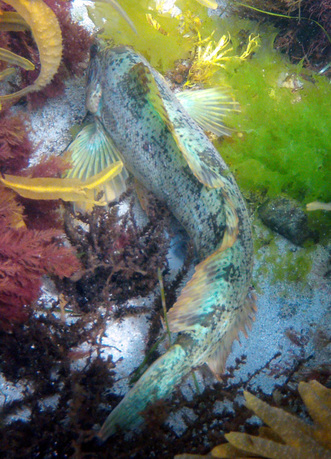Whitespotted greenling • Hexagrammos stelleri
 Photo by Rosie Child
Photo by Rosie Child
Identification
The whitespotted greenling has a brownish-green body with red tinges and dark blotches and bars. White spots dots its head and back. There is a bristly appendage (cirrus) above both eyes. Dark streaks or blotches mark the fins. In winter, while protecting its eggs, the fins of the more golden-coloured male become temporarily darker. This species gets to almost 50 cm long. Click here for more photos.
Habitat & Range
The whitespotted greenling can be found along shallow, sandy shorelines as well as around rocky outcrops and pilings, and especially among eelgrass and other seaweed. It is more common at a depth less than 15 m, but has been recorded to 275 m. Its range extends along both coasts of the North Pacific, from northern Alaska to Oregon and from Siberia to Japan.
Human Uses
Whitespotted greenling are an easy catch for recreational fishermen; the more silvery-coloured juveniles are often caught by novice anglers.
Intriguing Info
The male whitespotted greenling will fearlessly guard its bright turquoise or mauve eggs in the winter, going so far as to circle and nip at unsuspecting divers who get too close.
iNaturalist
https://www.inaturalist.org/taxa/186849-Hexagrammos-stelleri
The whitespotted greenling has a brownish-green body with red tinges and dark blotches and bars. White spots dots its head and back. There is a bristly appendage (cirrus) above both eyes. Dark streaks or blotches mark the fins. In winter, while protecting its eggs, the fins of the more golden-coloured male become temporarily darker. This species gets to almost 50 cm long. Click here for more photos.
Habitat & Range
The whitespotted greenling can be found along shallow, sandy shorelines as well as around rocky outcrops and pilings, and especially among eelgrass and other seaweed. It is more common at a depth less than 15 m, but has been recorded to 275 m. Its range extends along both coasts of the North Pacific, from northern Alaska to Oregon and from Siberia to Japan.
Human Uses
Whitespotted greenling are an easy catch for recreational fishermen; the more silvery-coloured juveniles are often caught by novice anglers.
Intriguing Info
The male whitespotted greenling will fearlessly guard its bright turquoise or mauve eggs in the winter, going so far as to circle and nip at unsuspecting divers who get too close.
iNaturalist
https://www.inaturalist.org/taxa/186849-Hexagrammos-stelleri
References
Froese, R. and Luna, S.M. Hexagrammos stelleri Tilesius, 1810. FishBase. Accessed 19/11/2014.
Lamb, A. and Edgell, P. Coastal Fishes of the Pacific Northwest. Revised. (2010). Madeira Park, BC: Harbour Publishing. Pp. 191-193.
Lamb, A., and Hanby, B. (2005). Marine Life of the Pacific Northwest [electronic version]. Madeira Park, BC: Harbour Publishing.
Whitespotted greenling. Fishing & Shellfishing. Washington Department of Fish and Wildlife. Accessed 19/11/2014.
Authors and editors of page
Kelly Fretwell and Brian Starzomski (2014).
Froese, R. and Luna, S.M. Hexagrammos stelleri Tilesius, 1810. FishBase. Accessed 19/11/2014.
Lamb, A. and Edgell, P. Coastal Fishes of the Pacific Northwest. Revised. (2010). Madeira Park, BC: Harbour Publishing. Pp. 191-193.
Lamb, A., and Hanby, B. (2005). Marine Life of the Pacific Northwest [electronic version]. Madeira Park, BC: Harbour Publishing.
Whitespotted greenling. Fishing & Shellfishing. Washington Department of Fish and Wildlife. Accessed 19/11/2014.
Authors and editors of page
Kelly Fretwell and Brian Starzomski (2014).




